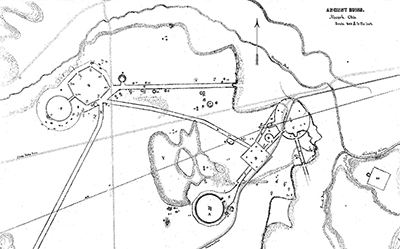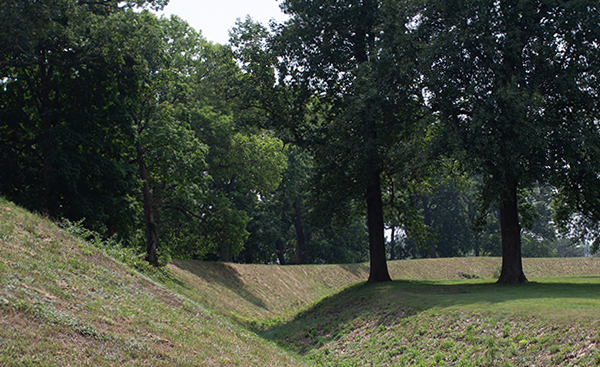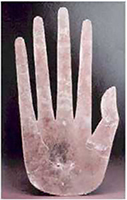Newark Earthworks, Ohio, an UNESCO World Heritage Site

Site: Newark Earthworks - Heath, Ohio
Locations: Great Circle - 455 Hebron Rd, Heath, OH 43056
Google Maps Link
Octagon Earthworks - 101 N 34th St, Newark, OH 43055 Moundbuilders Country Club
Google Maps Link
Wright Earthworks - 136-154 James St, Newark, OH 43055
Google Maps Link
Date of visit: July 2024
The Newark Earthworks originally covered four square miles and was the largest Ohio Hopewell site. At the time of the Ohio Hopewell culture, the land was prairie, maintained by controlled burning. Later maps, such as in the book, Ancient Monuments of the Mississippi Valley, show it partially forested. On my mini-mound tour, I visited the Fairground Circle and Octagon Earthworks Overlook at Moundbuilders Country Club. Driving to the Fairground or Great Circle, we took U.S. Route 79, which follows the path of the Ohio Canal, built around 1825. I was surprised to see how close the canal was, its construction, and the building of the city of Newark that contributed to the destruction of the eastern part of the site. The Wright Earthworks is a portion of the square enclosure that is about .8 miles away from the Fairground Circle. The old maps show a shallow lake or pond in the middle of the site. It was not an excavation by the moundbuilders but natural. This was later drained for cultivation. The Ancient Monuments of the Mississippi Valley notes that after the New Madrid, MO earthquake of 1811, water rose to a depth of 10 feet. Now, it is an urban neighborhood, as is most of the site.

Great or Fairground Circle
The Fairground Circle has a peaceful park-like setting. Walking to the entrance, I saw a large hawk fly from tree to tree. Once inside, I saw two hawks, one with banded wings, dive-bombing the other. The entrance wall and the inside moat or ditch were impressive. The ditches were 6 to 7 feet deep. Dr. Brad Lepper suggests that the ditches had a clay and limestone lining that held water, and the lining was broken over the years, so it no longer holds water. However, there were no visible sources of water to fill them. The map of Newark in Ancient Monuments of the Mississippi Valley shows four other smaller circle enclosures with interior ditches at the site. In 1992, a team with Dr. Brad Lepper dug a trench through an embankment wall. They found that the wall was built in two stages, using yellow-brown and later dark-brown soil from the ditches. The walls would have looked yellow-brown on the inside and dark brown on the outside.

Octagon Earthworks
I was confused when I first looked at the site from the overlook platform. Some of it was the size of the enclosure and the golf course. We were in the middle, where a walled walkway connected the circle and octagon. There, we could get a good view of a smaller mound that blocked one of the gateways of the octagon. Two professors from Earlham College, Ray Hively and Bob Horn, researched the lunar alignments of the octagon. Their first step was to get accurate measurements of the site. They didn't pursue astronomical alignments because there wasn't an exact date when the sightings would have occurred. They found no alignments with the sun but a very precise alignment with the moon's extreme rise and set points, which happens in an 18.6-year cycle called a Lunar Standstill. They thought that part of the eastern wall had been made slightly less symmetrical to allow the sighting of the Lunar Standstill to work.
The Great Hopewell Road
Throughout the site, walkways guided visitors or ancient pilgrims from the waterways to the major features, and it is thought that extended walkways led 60 miles from the site to Chillicothe. Also, a ceremonial road has been suggested to lead to High Bank Earthworks, the only other Ohio Hopewell culture site with a similar circle and octagon.

Exotic Materials
The Ohio Hopewell culture had access to copper, marine shells, mica, galena, pipestone, obsidian, and meteoritic iron. Flint Ridge is close to the Newark Earthworks and produces beautiful jewel-quality stones. Were people drawn to the area for trade? Some researchers have suggested that Newark was a place of pilgrimage, and groups from there would travel to other areas to obtain the materials. Although the Ohio Hopewell culture created various items like ear spools and other jewelry, similar artifacts are not found at the sources, which discounts the idea of direct trade. I am intrigued by the use of mica sheets. One mound in the Elipse near the eastern part of site was reported to be covered with mica sheets, and they were also found at the excavation of the Eagle mound. There are photos of hand and cougar claw shaped from mica.
The www.ancientohiotrail.org website contains more information about Newark Earthworks. An online PDF details Ray Hively and Bob Horn's work; see the links below.
Links to more information
-
Earthworks: How we found the lunar alignments at the Octagon Ray Hively and Bob Horn
www.newarkadvocate.com - The Archaeoastromony of the Newark Earthworks www.ohiohistory.org
- Vol. 1 Ch. 5 Hopewell Topography, Geometry, and Astronomy in the Hopewell Core by Ray Hively,and Robert Horn, Earlham College. Download or read PDF online. ideaexchange.uakron.edu
- Ohio's Flint Ridge www.rockngem.com
References
- Lynott, M. J. (2014) Hopewell Ceremonial Landscapes of Ohio
(Paperback Edition: 978-1-78297-754-4) Oxbow Books
Link to the book on Oxbow Books - Squier, E.G and Davis, E.H. (1988) Ancient Monuments of the Mississippi Valley
(Paperback Edition: 978-1-56098-725-3) Smithsonian Books; 150th anniversary ed edition (October 17, 1998)
Available as a PDF at the U.S. Library of Congress Website.